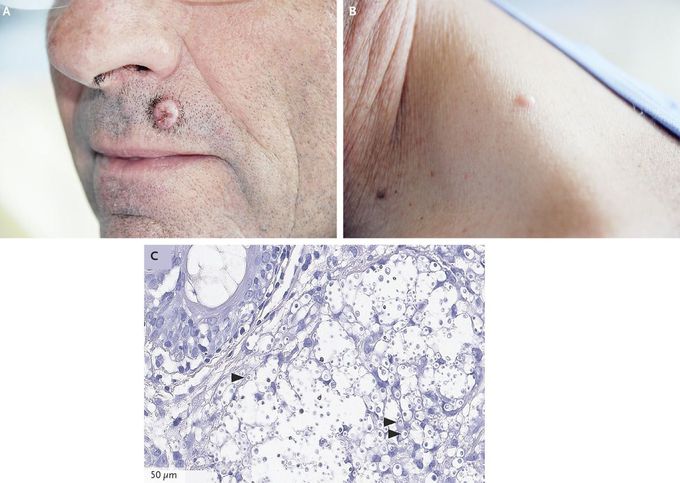


Disseminated Cryptococcosis
A 60-year-old man presented with a 4-week history of progressive skin lesions. For the past 6 years, he had been treated for chronic lymphocytic leukemia (CLL) with successive administration of a combination of rituximab, fludarabine, and cyclophosphamide, a combination of alemtuzumab and dexamethasone, and a combination of rituximab, bendamustine, and methylprednisolone, to which he had had a partial response. His blood CD4+ T-cell count was 20 per cubic millimeter (1%). The physical examination revealed multiple papules of various sizes that were sometimes umbilicated and were located mainly on his face but also on his shoulders, arms, and legs (Panels A and B). The patient also had polyadenopathy related to the CLL. He was otherwise asymptomatic and, in particular, did not present with fever, a decline in general health, or neurologic signs such as headaches, altered mental status, or neck stiffness. The biopsy of one papule revealed numerous encapsulated yeast forms (Panel C, arrowheads; hematoxylin and eosin). Cryptococcus neoformans was cultured from cerebrospinal fluid, blood, urine, and skin, and a test for serum cryptococcal antigen was positive at a titer of 1:400. Amphotericin B plus flucytosine was administered for 3 weeks before he was transitioned to fluconazole. The skin lesions gradually disappeared, with a decrease in the serum cryptococcal antigen titer.
Y ampho and flucytosin for 3 weeks, guidelines mention that it should be given for 1 week then the next week is 1200 mg fluconazole followed by 8 weeks of 800mg fluconazole


